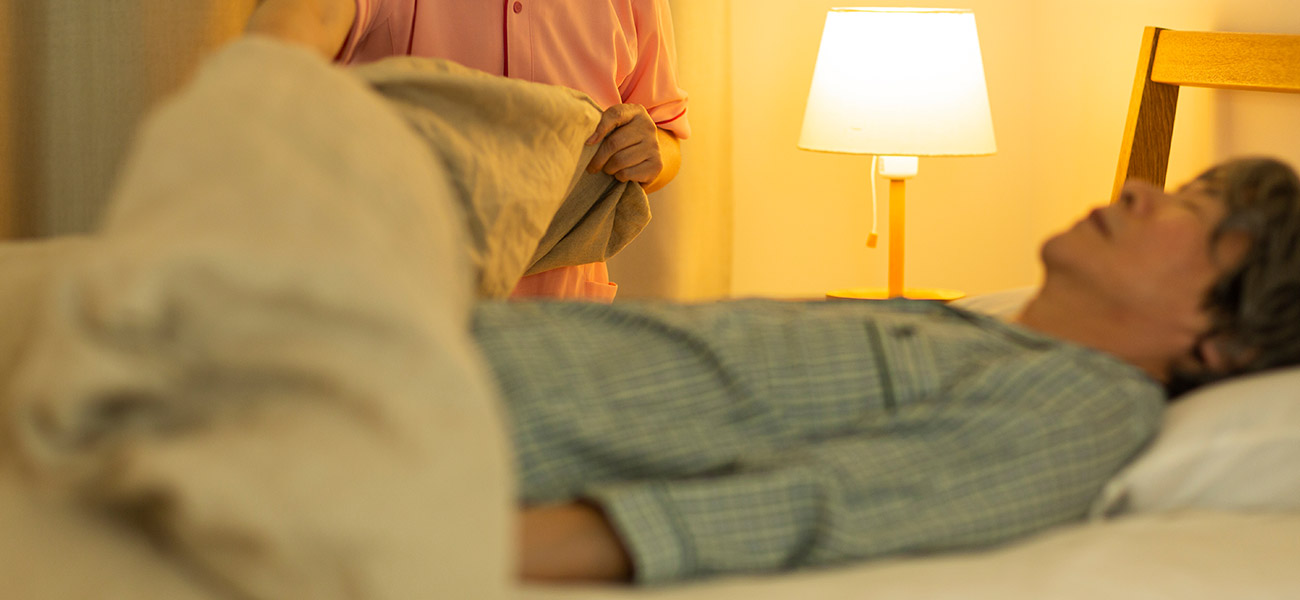Nighttime Routines for Caregivers Managing Incontinence
For family members and caregivers, “attending” loved ones with incontinence, offers its unique challenges, especially at night time. Sleep is essential for physical recovery and emotional recovery, but fear of mishaps jeopardizes peaceful nights for everyone. A thoughtful nighttime routine not only limits leaks but also helps your loved one feel secure and taken care of—allowing both of you to enjoy more restful sleep.
If you are a caregiver managing these nighttime concerns, this blog offers easy guidance and helpful tips to bring an easier and more calming bedtime for everyone.
Why Nighttime Can Be Difficult
In contrast to daytime—when normal bathroom trips and clothing changes can be relatively easily accommodated—nights involve longer stretches of inactivity. For the person with urinary incontinence, this can result in heightened concern about leaks, odors, or even skin irritation.
For caregivers, the anxiety of constant checks or shaken sleep can become draining over time.
By establishing a regular, compassionate evening routine, you can do your part to reduce both your own and your loved one’s stress—while keeping them worry free and healthy.
Step 1: Establish a Quiet and Predictable Evening Routine
Begin by establishing a quiet, predictable routine in the evening. Known activities can signal the body and mind that it’s time to relax. This may involve:
A light meal (skipping diuretics such as caffeine and alcohol)
A warm bath or sponge-down to unwind the body
Listening to soothing music, prayer, or light reading
Using the bathroom before bedtime to reduce nighttime urgency
A calming routine can decrease anxiety, encourage bladder emptying at bedtime, and help your loved one relax into a more peaceful state.
Step 2: Selecting the Appropriate Incontinence Products
Overnight requires more incontinence products with greater absorbency. Adult diapers such as Lifree’s are specifically designed for nighttime wear. Not only do they offer extra protection, but they also tend to reduce nighttime changes, which can be such a nuisance.
Buy products that have:
Higher absorbency for extended wear
Breathable materials to minimize skin irritation
A close-fitting but comfortable fit to avoid leaks
Odor-control features for that extra peace of mind
If you’re a first-time user of incontinence wear, try trial packs or ask your doctor for the correct fit and product type.
Step 3: Safeguard the Bedding Intelligently
Despite an adult diaper that fits well, incontinence accidents do occasionally occur. Rather than fretting, take preventive measures to prevent damage to the bed and simplify cleanups.
Here’s what to do:
Place a waterproof mattress protector beneath the bedding
Add an absorbent bed pad (disposable or washable) on top of the sheet for easy removal in the event of accidents
Have a spare set of sheets, bed pads, and nightclothes within arm’s reach
These easy changes can enable you to act fast in the dead of night without disturbing anyone else or stumbling in the dark.
Step 4: Maintain Skin Health and Hygiene
Long-term exposure to moisture—particularly while sleeping—can result in skin irritation, rashes, or infection. Nightly routine should include tender skin care on your loved one’s part.
Attempt these steps:
Gently clean the skin with fragrance-free, alcohol-free wipes at bedtime
Use a barrier cream or zinc-based ointment on sensitive areas
Promote side lying, if tolerated, to decrease pressure on an area
Skin care is as essential as leak management. A couple of minutes before bedtime can pay a lot of dividends in avoiding misery later on.
Step 5: Have a Night Kit Prepared
To avoid searching through drawers in the dark, put together a mini “night care kit” to have handy. This might be:
Extra adult diapers
Disposable gloves
Wipes
Bed pads
A spare change of clothes
Skin ointment or moisturizer
A flashlight or motion-sensor light
Having everything you need ready can allow you to react fast and get back to bed with little ado.
Step 6: Manage Emotional Well-being
Incontinence might create feelings of shame or irritation for the individual involved. That’s why how you react is as important as the products you have.
At nighttime, provide reassurance:
Gently remind them that accidents are not shameful
Talk in a soothing voice and with kindness, particularly with changes
Prioritize their well-being, not cleanliness
A comforting word or gentle touch can calm fears and ease your loved one into sleep feeling secure. When they feel supported emotionally, it’s a more positive experience for both of you.
Step 7: Plan for Minimal Disruptions
It’s best if both you and the one you’re caring for can sleep throughout the night. With proper preparation, you might not have to rouse them as often.
A few caregivers find it useful to:
Encourage the final bathroom trip 30–60 minutes before bedtime
Adjust fluid intake late in the evening (without cutting down on overall daily hydration)
Use an absorbent nighttime diaper that can last for 8–10 hours
Avoid lifting or changing if absolutely unavoidable
If a mid-night adjustment needs to be made, attempt to maintain low lights and movements softly so as not to wake your loved one completely.
Step 8: Care for Yourself, Too
Lastly, remember that your own health is important. It is harder to be caring when you are tired and overwhelmed. Prioritize your sleep, and if possible, trade off evening tasks with another family member or hire professional help a few nights a week.
Final Thoughts
Controlling incontinence at nighttime can be scary—but with the right planning and compassion, you can make night’s rest more easy for both you and your loved one.
Utilizing appropriate products such as Lifree Adult Diapers, and providing emotional well-being can work wonders in making seniors feel confident, secure, and rested.Your love makes all the difference—and each tiny act of love counts to a big difference in your loved one’s life.
FAQ’s
2. How can caregivers prepare for the night to manage incontinence?
Caregivers can prepare for nighttime incontinence management by setting up essentials in advance. This includes keeping fresh clothes, adult diapers, bed protectors, and wipes nearby. Ensure the person uses the toilet before bedtime to reduce chances of leakage. Choose the right incontinence products designed for night use as they offer longer protection. Place a waterproof sheet under the bedsheet to protect the mattress. Soft nightwear and easy-to-remove clothing help in changing quickly. Having a night light in the room also prevents accidents during nighttime bathroom trips. Preparation helps reduce stress for the caregiver and ensures the person sleeps more comfortably and securely through the night.
3. What kind of incontinence products are best for nighttime?
Nighttime incontinence products should offer high absorbency, long-lasting dryness, and comfort. Choose adult diapers or pants that are specially made for nighttime use, as they are designed to handle more volume. Look for products that offer extra leak protection, a snug fit, and breathable materials to prevent skin discomfort. Elastic waistbands or pants with side tapes are easier to use and adjust. Products with odor control and wetness indicators are also helpful. Using a bed protector or absorbent sheet adds an extra layer of protection. The right product will reduce the number of night changes and help both the caregiver and the person get better sleep.
4. How often should incontinence wear be changed during the night?
Changing frequency depends on the product and the individual’s needs. Some high-absorbency diapers can last through the night, while others may need to be changed once. If there is leakage or discomfort, a change is necessary. It's a good idea to check once during the night, especially in the early hours. Wetness indicators on some diapers can help you know if it’s time to change. Frequent changes help prevent rashes, discomfort, and infections. However, avoid waking the person too often unless necessary, as rest is also important. If leakage is a frequent issue, you may need a higher absorbency product or add a bed protector.
5. How can caregivers ensure proper hygiene at night?
To ensure hygiene, always keep clean wipes, hand sanitizer, and extra clothing nearby. Before bed, make sure the person has cleaned up properly and changed into fresh nightwear. If a diaper is used, it should be snug and secure to avoid leaks. If a change is needed at night, do it gently and quickly to reduce sleep disturbance. Dispose of used products properly in a sealed bag or bin. Wash hands thoroughly after every change. Using skin-friendly wipes and barrier creams can also protect against rashes. Keeping the room ventilated and the bedding clean helps maintain overall hygiene and comfort.
6. What are the signs that a nighttime routine needs adjustment?
If there are frequent leaks, rashes, disturbed sleep, or discomfort, the routine might need a change. Waking up multiple times at night or finding the bed wet regularly are also signs. Changes in the person’s health, mobility, or sleep habits can affect the routine. Also, if the caregiver feels overwhelmed or tired, it’s time to reassess the routine for better balance. Sometimes the incontinence product may no longer be effective and a different one might be needed. Keeping track of nighttime issues for a few days helps understand what’s not working. Adjusting bedtime, bathroom visits, or product types can improve the situation.
7. How can caregivers help reduce stress for the person during nighttime?
Creating a calm bedtime routine can reduce stress. Avoid loud noises or bright lights before sleep. Offer a warm drink (without caffeine), ensure they visit the washroom, and help them into comfortable nightwear. Reassure them kindly and speak softly if they feel anxious. Make the bed comfortable with clean sheets and pillows. Using a night light and keeping essentials nearby makes them feel safe. Gentle background music or a bedtime story may also help if they enjoy it. Respecting their privacy and involving them in decisions about their care can make them feel more confident and secure.
8. What role does communication play in nighttime incontinence care?
Communication is key. Talk to the person kindly about their needs and preferences. Let them know you are there to help, not to judge. Ask if they’re feeling discomfort or if something is bothering them. Be patient and listen, especially if they feel embarrassed. Clear communication builds trust and makes care easier. It also helps you understand what adjustments are needed. For example, they might prefer a specific kind of diaper or dislike a certain routine. Keep instructions clear and simple, especially if they have trouble understanding or remembering things. Positive communication leads to better sleep and care.
9. Can technology help in nighttime incontinence care?
Yes, some technologies can assist with nighttime incontinence care. There are wearable sensors that alert caregivers when the diaper is wet, so changes happen at the right time. Some smart beds or mattress protectors detect moisture and send alerts. Timers or alarms can remind caregivers when to check or change the diaper. Bedside lights with motion sensors make it easier to get up without disturbing others. Apps can help track patterns and products used, helping plan better. While not everyone may need these, they can be useful tools, especially for caregivers who are managing alone or looking after more than one person.
10. How can caregivers take care of themselves while managing nighttime routines?
Caring for someone at night is tiring. Caregivers must also look after their own health. Try to sleep during the day if nights are interrupted. Ask for help from family or other caregivers when needed. Taking short breaks, doing light exercise, or speaking to someone about your feelings can help reduce stress. Prepare ahead so your nights go smoothly, and try to limit how many times you wake up. Keeping your own hygiene, eating on time, and managing your sleep is important too. Remember, a healthy caregiver can give better care. Don’t hesitate to seek support or advice when you need it.






















